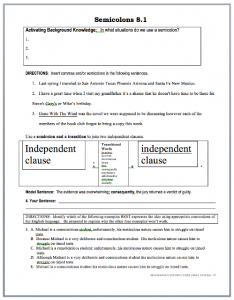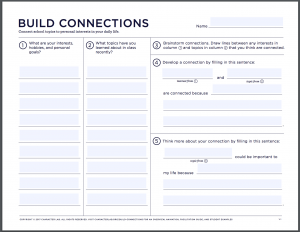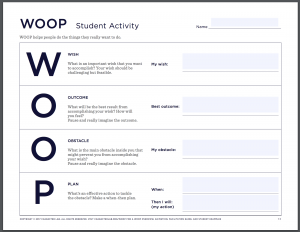Dear colleague,
It's common enough to hear a well-meaning teacher use language like this:
- Worksheets are the worst.
- There should be zero worksheets allowed in schools.
- Only bad teachers use worksheets.
In one sense, I get it. When a class period becomes nothing more than a teacher distributing worksheet after worksheet to keep kids busy, that class is falling short of its potential. Our job is to teach, not to chuck worksheets at kids.
But — but! — there are instances where things that look an awful lot like worksheets are simply the best and most efficient means through which to achieve a certain instructional goal. I have three examples, and what I hope to demonstrate with them is that it's not worksheets that are the worst — it's poor thinking about teaching and learning. A worksheet, after all, is an inanimate object.
First, consider Mechanics Instruction that Sticks, a warm-ups curriculum that my colleague Doug Stark built out during the final summers of his teaching career. If you simply take Doug's pack of warm-ups and chuck them at your students, letting them work alone while you zone out, then yes, that's malpractice. But if you read Doug's instructions on “How to Use the Warm-Ups,” it doesn't take long to move away from that kind of thing.
The warm-ups will not work if you use them like worksheets. You can’t just hand them out and let the kids go. I try to think of each warm-up as an interactive lesson with multiple checks for understanding.
Later, Doug goes further.
Using warm-ups or any other type of worksheet will have zero effect on student achievement if it is not tied to extensive, repeated opportunities to write. I have always looked at these warm-ups as mini-lessons designed to improve the writing ability of my students, not as a replacement for authentic writing.
It's this thoughtfulness around the warm-ups that transforms them from what we often mean when we say “worksheets” and into an integral, efficient part of an impactful writing classroom. Doug has simply taken his hard-earned awareness of the knowledge and skills students need for conventional writing and boiled it all down into the most efficient tool he can devise.
Yet if you walked into Doug's room during one of his warm-up mini-lessons and had a hardened bias against all things that look like worksheets, you' could easily'd probably be blind to the master teaching happening at that moment and instead (foolishly) disdain it.
Next, consider the Build Connections exercise that Chris Hulleman and Character Lab put together some years ago. On its face, it's a single-sided worksheet with lots of neat lines for kids to write on. You could, once again, take this thing, chuck it at your students, and head to your favorite news site while they scratch their heads and try to puzzle through it.
But in the hands of an earnest teacher who takes the time to read the science and strategies behind this worksheet (I wrote about this early this school year here, and we discuss the tool in-depth inside the Student Motivation Course), this can become a recurring tool for creating pair, small group, and whole-class discussions around how Algebra or Physics or Hamlet or the Han Dynasty relates to students' actual lives. In short, it's a tool for helping kids become better, more motivated thinkers and learners. It's awesome.
(Note: I haven't used Hullmen's printout in a long time because it's structure is ingrained in my mind. Now I walk students through the process on the document camera — you can watch me do that with this year's students right here.)
Finally, let's look at WOOP — thought-child of the brilliant Gabriele Oettingen. At a conference in Philly back in 2018, Gabriele Oettingen led us through the WOOP goal-setting protocol, using this worksheet as a tool for the process. There were practically tears by the end from multiple participants because it was so beautifully done. Like the other two examples in this post, the WOOP sheet is designed to expedite the WOOP process. In the hands of a teacher who invests the time into studying and using WOOP, both in her own life and in her classroom, this is the furthest thing from a mindless, time-wasting, or “busy work” kind of activity.
(I've written about WOOP here and led teachers through it here. We also discuss the mechanics of WOOP in the Student Motivation Course.)
The Gist
My point is broader than the relative utility of a given sheet of paper in a teacher's classroom. It's that: we've got to teach in a way that makes sense. The primary aim of professional development is to develop a teacher's clarity and depth of understanding around how learning works. Sweeping statements like “worksheets are the worst,” “all books are good books,” “desks in rows are terrible…” these provide the illusion of clarity (all over-generalizations do) but not clarity's substance.
Teaching right beside you,
DSJR



Jamie says
I really appreciate the suggestion to check out Mechanics Instruction that Sticks. I have been seeking a resource as flexible… and, until now, have just created my own worksheets with mini-lessons on Slides (following assessment… identifying common “grow” areas). This will save me a lot of time/effort. I just purchased BCD package and will study it over the summer. Thank you.
Dave Stuart Jr. says
It’s an amazing resource, Jamie — and I can say that without blushing because I’m not the author, just the publisher for my brilliant friend Doug!